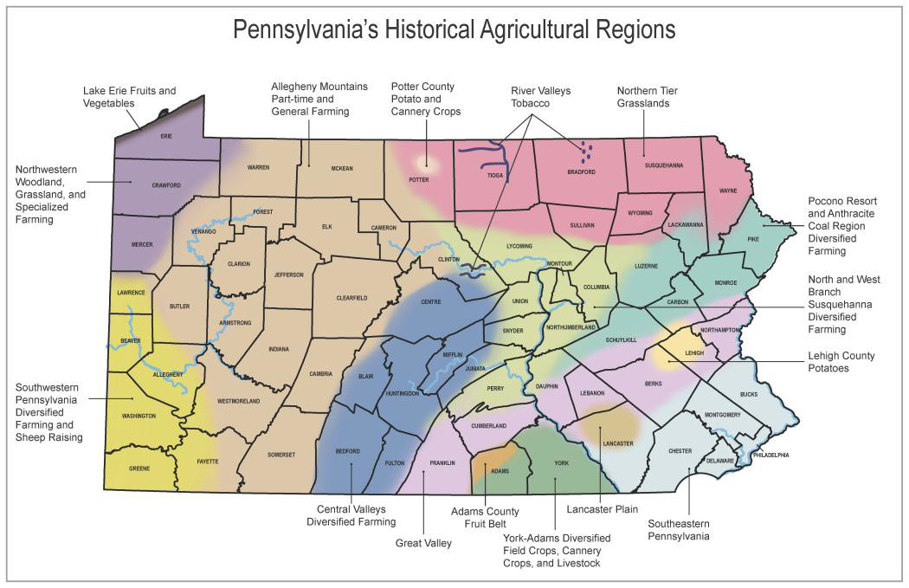This post contains updates to the statewide agricultural context, also known as the Pennsylvania Agricultural History Project, through January 2022. The development and implementation of Pennsylvania’s Historic & Archaeological Resource Exchange (PA-SHARE) has necessitate updates to the way information is collected and provided to the PA SHPO.
The updates include the following components, which are also included in Agricultural Context Guidance (Updated January 2022):
Required Attachments. As part of efforts to improve the documentation of farms, SHPO will be requiring specific attachments for Identification- and Evaluation-level documentation. Required attachments guidance.
Model Documentation for Farms. Examples for a site plan, historic aerial comparison, and property history and agricultural context are found as appendices in the Additional Guidance document and should be referenced to understand how graphics and census data should be presented. These examples are also available at these links:
The following updates were made in 2019 and have not changed:
Agricultural Assessment Worksheets. The worksheets are to be provided as an attachment to the HRSF. Their purpose is to summarize the registration requirements for the identified regions and time periods, including 1960 to 1980. These worksheets are available as Appendix A in the Additional Guidance Document and on the website.
Determining Farm Production Levels After 1927: Oral Interviews, Aerial Comparisons, and Comparative Property Types. For those years U.S. Agricultural Census data is available (1850, 1880, 1927), the statewide agricultural context recommends using federal census data as a clue in determining if a farm exhibits regional trends. This involves a comparison of an individual farm’s production to the average production level of farms in the township at the time. Unfortunately, after 1927, census data on agricultural production is not available at the individual farm level. Thus, additional guidance was developed to help researchers assess production trends for agricultural properties operating after 1927.
Interviewing current or former farm occupants can provide valuable insights into the farm’s evolution and production. The questions focus on agricultural production and changes to the farm complex and landscape in recent memory. A sample list of questions to ask when conducting oral interviews with current or former farm owners or operators is available in Appendix B of Additional Guidance Document and on the website.
Comparing the historic aerial photos to recent aerial imagery helps clarify how—and how much—a farm’s landscape has evolved and point to changes in the farm’s production, equipment, and technology as well as local economic and development patterns that impact farms. These photographs are essential tools and readily available online for most parts of Pennsylvania. Aerial photographs covering the commonwealth is available through Pennsylvania Spatial Data Access (PASDA) at https://www.pasda.psu.edu/uci/SearchResults.aspx?Shortcut=aerial. Guidance for interpreting historic aerial photographs to determine farm production is available in Appendix C of the Additional Guidance Document and on the website.
When the former farm owner or producer is not available to answer questions on production or an examination of historic aerials doesn’t yield enough information, comparative property types is another tool that can be used. In this period farms with buildings larger in number and size tend to reflect high levers of production. Compare how the 50-year-old buildings that make up the farmstead compares to neighboring farmsteads. A maximum of a one-mile radius should be used for comparative property types.
Agriculture Resource of Pennsylvania, c. 1960-1980. Includes a narrative history and registration requirements for primary agricultural products for farms between 1960 and 1980. Regionalized diversification in agricultural production largely disappeared in this period so the focus is on how the built environment and landscape reflect statewide agricultural trends. Due to the growth of the Plain Sect, largely Amish population, in this period and their ties to agrarian lifestyles, an additional cultural/religious group and related property type are also recognized.
Updates to the Statement of Integrity. The updates to the statement of integrity address alterations on the Plain Sect (Amish) farmstead and new construction within the farm plan.

Important!
Please note the purpose of the update is to provide needed clarification for determination of eligibility; the update is not a formal update to the MPDF but an evolving and ongoing effort to provide continual guidance updates to benefit our staff and regular users of the context.
History of the Pennsylvania Agricultural History Project
As outlined in a past posting, the ambitious Pennsylvania Agricultural History Project was begun in 2001 and completed in 2013. The project included the creation of a statewide agricultural context for the National Register evaluation of agricultural properties, entitled “Agricultural Resources of Pennsylvania, 1700-1960, Multiple Property Documentation Form (MPDF)”.
Sixteen agricultural regions were identified based on factors such as product mix, labor and mechanization, tenancy, culture and ethnicity. Separate contexts, property types, and registration requirements were developed for each of the agricultural regions.

The statewide agricultural context allows for more consistent and expeditious National Register eligibility evaluations (over 1,900 so far). Most of these resources (approximately 1,800) have been evaluated as a result of the Section 106 and State History Code review processes.
Over the course of the last six years, SHPO and PennDOT staff have recognized a need to provide more tools and guidance for implementation of the context, especially addressing post-1960 changes to farms. As a result, a joint effort was undertaken in 2017-2019, once again involving a partnership between the Pennsylvania Historical and Museum Commission, the Pennsylvania Department of Transportation, and Dr. Sally McMurry of Pennsylvania State University with funding from the Federal Highway Administration.
Comment Policy
PHMC welcomes and encourages topic-related comments on this blog. PHMC reserves the right to remove comments that in PHMC’s discretion do not follow participation guidelines.
Commenters and Comments shall be related to the blog post topic and respectful of others who use this site.
Commenters and Comments shall not: use language that is offensive, inflammatory or provocative (this includes, but is not limited to, using profanity, obscene, or vulgar comments); disparage other commenters or people; condone illegal activity; identify the location of known or suspected archeological sites; post personal information in comments such as addresses, phone numbers, e-mail addresses or other contact details, which may relate to you or other individuals; impersonate or falsely claim to represent a person or an organization; make any commercial endorsement or promotion of any product, service or publication.
If you would like to comment on other topics not related to this blog post but related to PHMC, please fill out the PHMC Contact Us Form.

Hi,
I appreciate the PA Ag History Project.
I was researching a farm in Upper Chichester, Delaware County, as of 1850,
and stumbled on this problem.
This link to the static 2015 web site:
http://www.phmc.state.pa.us/portal/communities/agriculture/files/1850/manuscripts/delaware/1850_Delaware_Upper%20Chichester%20Twp.pdf
shows only the second pair of pages (3 and 4) for that town.
(The missing page 1 is included in the grand total.)
Perhaps someone at PHMC has the original reel or set of images.
Thank you for bringing this to our attention. We are in the process of updating materials on the website and will work to resolve this issue.